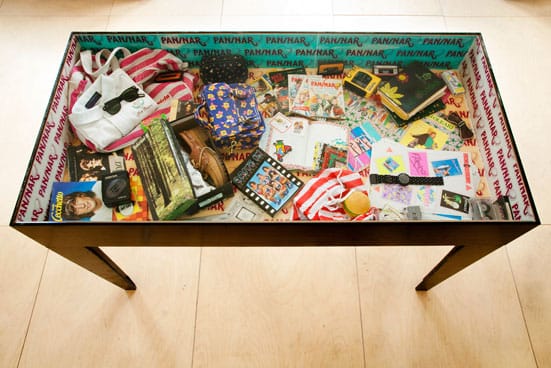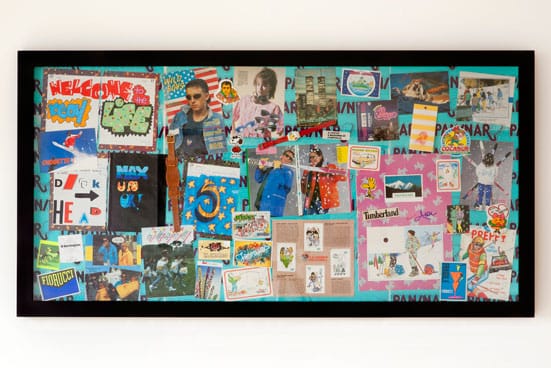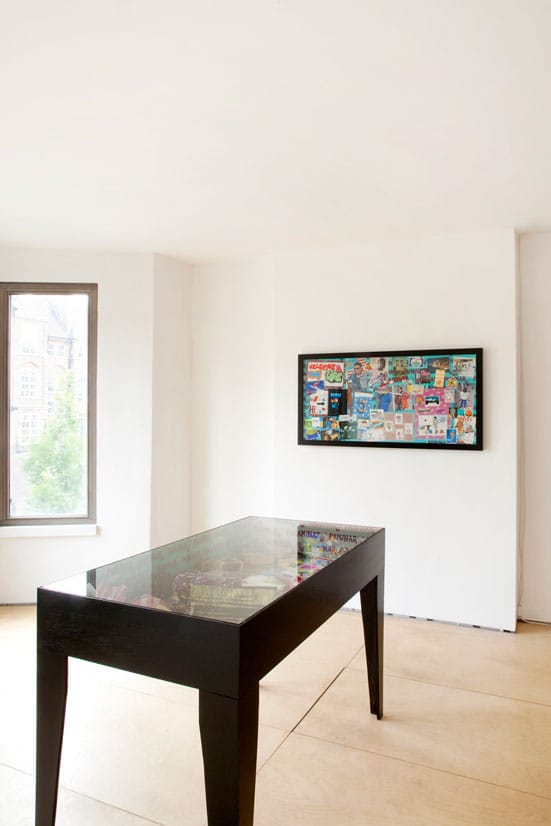AL: Could the investigation of the Paninaro scene in this present body of work be considered a continuation of some of the threads visible in the wallpaper pieces?
LG: Absolutely. Through the giant decollages I collect hedonistic iconography and create patterns out of it, which are then juxtaposed by layering the wallpapers unto one another. The approach has become increasingly anthropological and one of the keys is to look for forms of excess thought history and draw a comparison, even if just visual, to more recent ones.
The Paninaro embodies the naïve pre-teen consumer, a true hedonist in the sense that nothing else but consumption and leisure matter to him. I am looking at the Paninaro phenomenon because it was quite unique in its manifestations. Born in the early 80's, when the textile industry in northern Italy was in full bloom and bringing prosperity to the local areas, it represents a pivotal moment in which the fashion industry wasn't only producing luxury goods but also catering (and creating) for a fashion conscious pre-teen and teen market.
Often the textile factories themselves were also fashion houses and produced their own lines. For instance, Naj-Oleari, who offered an entire galaxy of products. Heavily patterned garments became their trademark; you could buy anything from a hairband to socks to wallpaper to bed linen… All their advertising featured teenies covered in Naj-Oleari products launching a 'total look' that was quickly adopted by the Paninaro.
'Paninaro fashion' was mainly a re-elaboration of the American preppy look and featured lots of sporty leisurewear. The names of the brands, for example 'U.S. copy', reflected an American provenance, but half of them were produced in small factories around Mantova in northern Italy. You can tell they weren't produced in a native English speaking country because of the amount of spelling mistakes or bizarre grammar involved!
Hence the Paninaro investigation has become part of my hedonistic archive, and will translate into a wallpaper installation for Vitrine Gallery this October.
AL: How do you consider the works in The Agency exhibition will communicate with 21 century, UK audiences?
LG: I see the Paninaro as a solid embodiment of the American cultural colonisation that has been filtering globally since the 50's. It is very extreme and very visually legible within the Paninaro paraphernalia, I think this is something that people born before the 90's can relate to, independently from their provenance.
The Paninaro totally embraced all that was American to the point of naming themselves after a sandwich bar (Panino in English translates 'sandwich') and used as a meeting point the newly opened 'Burghys'. McDonald's was just about to open its' first restaurants in Milan and the novelty of the 'cheeseburger' and all it represented became their emblem. To me this show is an observation of 80's marketing strategies within the peak time of consumerism, when there was discussion of global warming but it hadn't become an asserted reality yet. It's an observation of the uber-optimistic, naïve and perhaps even innocent consumer that had no idea of the consequences of such a wasteful and throw away system would have in time. Eating out everyday at McDonald's wasn't seen yet as a hazard to one's health, rather like a fantastic colourful experience that came cheap.
AL: The Vomitorium sculptures are a recurring series in your current work. Please can you discuss the themes and language being developed in these pieces.
LG: The Vomitoriae are a series begun in November 2009 when I was looking at the binging roman orgies. Being born in Rome I grew up believing there was a place where the Romans used to relief themselves from overeating called 'Vomitorium'. There is no such place. Their embrace of hedonism knew no restraint; they used to vomit directly on the floor. It was considered polite, actually, like a good burp like a good burp within some traditions. Somewhere along the line the architectural term 'vomitorium', which identifies a passage/entry/exit that allows for big numbers of people to quickly enter and exit a stadium, became a fictional toilet for the acid reflux.
Intrigued by the discovery and coupled by the fact that I was reading Zygmunt Bauman's 'consuming life' at the time it felt only natural to explore the theme. In particular I am fascinated by Bauman's ideas around the impulse of consumption as one that we only truly satisfy when seeing the total consumption of the object/subject in question; one perhaps that needs to go one step further than annihilation.
That's when I realized the Romans had got there first!!!!
AL: It could it be said that the vitrines of related material present the Paninaro phenomenon in a historical context. With Berlusconi's government (and television stations) continuing to dictate to the public, what, if any, lineage of the movement is visible in Italy today?
LG: This is a very complex question, one that needs a show devoted to it in itself. I think the Paninaro was the beginning of the Berlusconian era, and by that I don't mean his political career but his media empire. Of course today this amounts to the same thing. His TV channels at the time were Retequattro, Canalecinque ed Italiauno and they showed imported soap-operas, like Dallas, and lots of American inspired extravaganzas, such as Drive-In. The latter in particular has become truly iconic in the way that it has shaped Italian television from then on in terms of the programme format and the use of 'Vallette' ('Dolly Bird') as a prominent feature. Perhaps it is in this very programme that we see the beginning of the Valletta superstar culture, and there is a character in Drive-In, 'Il Paninaro', played by comedian Enzo Braschi, that dictates the Paninaro look and beliefs.
In other words then were laid the building blocks of the Italian TV that we have today and consequently has had a massive cultural impact.
As part of the show at The Agency my dear friend Barbara Pansadoro has compiled a Pan-dictionary packed with hybrid American-Italian terms, that are part of everyday language today.
The Paninaro isn't much discussed in Italy nowadays, yet it is so symbolic of the massive cultural shift Italy has undergone in the past 30 years.
Ludovica Giosci's exhibition 'Paninaro' is currently on at the Agency Gallery
Adrian Lee

'Pan-Hotdog' & 'Pan-Cheeseburger' Vomitoriae, 2010
Wood, metal, fabric, wallpaper, plastic and gloss paint.
Pan-Hotdog measures 1.65m by 2.24m by 10cm and the base is 1m by 1.20m by 5cm.
Pan-Cheesburger measures 80cm by 120cm by 4cm and the base is 82cm by 84cm by 2cm.
PHOTOGRAPHY BY MICHELE PANZERI
Courtesy The Agency Gallery, London

'Pan-Vitrine', 2010
Paninaro paraphernalia, 72cm by 144cm by 88cm
PHOTOGRAPHY BY MICHELE PANZERI
Courtesy The Agency Gallery, London

'Summer Pan-Collection', 2010
Paninaro paraphernalia, 66cm by 130cm
PHOTOGRAPHY BY MICHELE PANZERI
Courtesy The Agency Gallery, London

'Winter Pan-Collection', 2010
Paninaro paraphernalia, 66cm by 130cm
PHOTOGRAPHY BY MICHELE PANZERI
Courtesy The Agency Gallery, London

'Paninaro',2010
Paninaro paraphernalia,wood, metal, fabric, wallpaper, plastic and gloss paint.
Installation, dimensions variable
PHOTOGRAPHY BY MICHELE PANZERI
Courtesy The Agency Gallery, London

'Paninaro',2010
Paninaro paraphernalia,wood, metal, fabric, wallpaper, plastic and gloss paint.
Installation, dimensions variable
PHOTOGRAPHY BY MICHELE PANZERI
Courtesy The Agency Gallery, London
